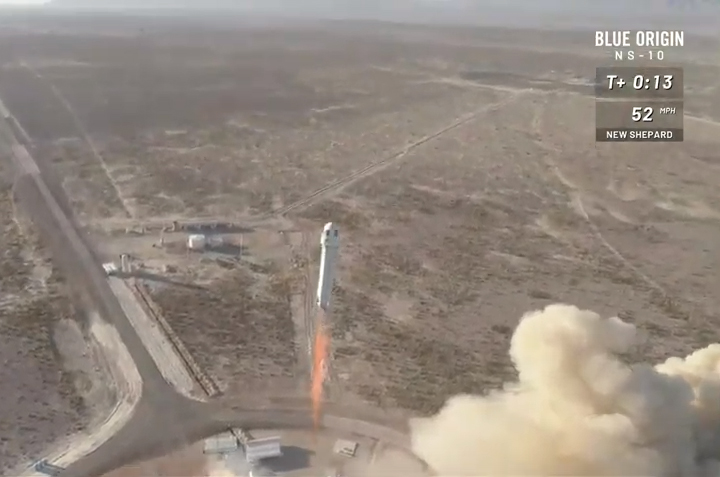Blue Origin's privately build New Shepard spacecraft has aced its biggest mission yet, and this time the spacecraft flew for NASA.
The reusable New Shepard launched into space today (Jan. 23) on its 10th-ever test flight, a brief uncrewed jaunt that carried at least eight NASA-sponsored research and technology payloads to suborbital space and back. The mission, which lasted 10 minutes and 15 seconds, reached an altitude of 66 miles (107 kilometers), Blue Origin officials said.
The mission began at 10:05 a.m. EST (1505 GMT), when the New Shepard rocket-capsule duo lifted off from Blue Origin's West Texas test site. The rocket soon came back down to Earth for a vertical touchdown, and the capsule followed suit with a parachute-aided landing on the dusty Texas plains. [Launch Photos! Blue Origin's New Shepard Soars on NS-10 Flight for NASA]
"Absolutely spectacular flight!" Blue Origin's Ariane Cornell, director of astronaut and orbital sales, said in live commentary as New Shepard landed successfully. "That, everybody, is a reusable rocket."

Blue Origin launched the NS-10 mission amidst a partial government shutdown, and while NASA did simulcast the launch via NASA TV, the agency is shuttered for the most part. NASA chief Jim Bridenstine provided recorded comments for the flight.
"At NASA, technology drives exploration," Bridenstine said, adding that there were 10 payloads in all on the flight. "These NASA-supported experiments will help advance in-space propulsion technologies habitation systems, science instruments and other capabilities crucial for exploration. Like the researchers, I'm excited to learn the results from this very important flight."
This was the fourth spaceflight for this particular New Shepard vehicle, which itself is the third such vehicle that Blue Origin has developed and flown over the years. The vehicle also performed suborbital test flights in December 2017, and in April and July of last year. [How Blue Origin's Suborbital Rocket Ride Works (Infographic)]
Get the Space.com Newsletter
Breaking space news, the latest updates on rocket launches, skywatching events and more!
Blue Origin, led by Amazon.com's billionaire founder Jeff Bezos, aims to fly paying passengers aboard New Shepard, perhaps as early as this year. But the company has not yet begun selling tickets or announced how much it will cost to book a seat.
Payload transportation is well underway, however, as today's flight showed. The eight experiments that had a brief encounter with the final frontier were a diverse lot, with some provided by NASA centers and others from universities sponsored by the agency.
One experiment, from the Carthage College Space Sciences Program and Kennedy Space Center, was designed to gauge fuel levels in microgravity using sound waves, for example; another by scientists at Johns Hopkins University Applied Physics Lab made measurements of Earth's electromagnetic field. Still another led by researchers at the University of Central Florida investigated how dust particles on the moon, Mars or asteroids might behave after being disturbed by exploration missions.
You can learn more about all eight payloads, which flew via NASA's Flight Opportunities program, at Blue Origin's mission-description page here.
Blue Origin isn't the only company seeking to exploit the suborbital niche. Virgin Galactic is developing a piloted, rocket-powered spaceliner called SpaceShipTwo to fly people and payloads to suborbital space. The newest SpaceShipTwo vehicle, called VSS Unity, made its first trip to space in December, and commercial operations could begin as soon as this year, Virgin Galactic founder Sir Richard Branson has said.
Blue Origin envisions New Shepard as a stepping stone to bigger and bolder things. The company is developing a heavy-lift rocket called New Glenn, for example, and Bezos has said that Blue Origin eventually aims to help get millions of people living and working in space.
Both New Shepard and New Glenn are named after pioneering NASA astronauts — Alan Shepard, who in May 1961 became the first American to reach space, and John Glenn, who launched on the nation's first crewed orbital flight in February 1962.
Mike Wall's book about the search for alien life, "Out There" (Grand Central Publishing, 2018; illustrated by Karl Tate) is out now. Follow him on Twitter @michaeldwall. Follow us @Spacedotcom or Facebook. Originally published on Space.com.
Join our Space Forums to keep talking space on the latest missions, night sky and more! And if you have a news tip, correction or comment, let us know at: community@space.com.

Michael Wall is a Senior Space Writer with Space.com and joined the team in 2010. He primarily covers exoplanets, spaceflight and military space, but has been known to dabble in the space art beat. His book about the search for alien life, "Out There," was published on Nov. 13, 2018. Before becoming a science writer, Michael worked as a herpetologist and wildlife biologist. He has a Ph.D. in evolutionary biology from the University of Sydney, Australia, a bachelor's degree from the University of Arizona, and a graduate certificate in science writing from the University of California, Santa Cruz. To find out what his latest project is, you can follow Michael on Twitter.









